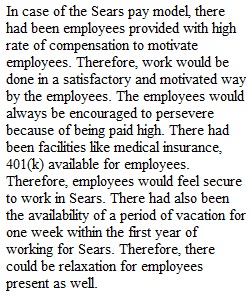


Q Case Discussion 14: Amazon versus Sears Although this case can stand alone, “Amazon versus Sanders” provides helpful context for it. Amazon has fundamentally changed consumers’ shopping experience, as Sears did decades earlier. But the two retail giants adopted starkly different compensation strategies, and that difference was further widened with changes to Amazon’s compensation policies (effective November 1, 2018) that phased out incentive pay and future stock grants while raising wages. Sears, founded in 1893, historically paid its workers generously and made heavy use of pensions and equity-based compensation. In the company’s heyday several decades ago, workers received a 401(k) with an annual contribution of about $2744 (in 2018 dollars), medical insurance, a week of vacation in the first year of employment, and potentially thousands of dollars per year in dividends from accumulated stock. Sears embraced profit sharing and had a generous and egalitarian program that based the company’s contributions to workers’ profit-sharing plans on years of service rather than on rank in the company, and the longest-serving employees received nearly $3 for every dollar that they contributed. Sears earmarked 10 percent of pretax earnings for a retirement plan for full-time employees, and the pension plan held a diverse portfolio of stocks and bonds and provided workers with fixed payments based on their salaries and tenure at the company. A typical salesperson retiring in the late 1960s had retirement savings of well over a million in 2018 dollars, much of it from Sears stock. By the 1950s, a quarter of Sears was employee owned. Amazon, founded in 1994, pays its full-time warehouse workers a 401(k), medical insurance, and a week of paid vacation in their first year, just like Sears did decades ago. Additionally, Amazon workers were receiving two shares of company stock per year, worth about $3500 total based on October 2018 stock prices. However, Amazon ended its stock program for employees on November 1, 2018. An Amazon warehouse worker hired after the program’s elimination and who stays with the company until retirement can expect considerably less than a Sears retiree received decades ago. If Amazon’s 575,000 total employees owned the same proportion of their employer’s stock as the Sears workers did in the 1950s, they would each own shares worth $381,000. To make up for the lost stocks under its new plan, Amazon increased its hourly minimum wage to $15 and gave raises of at least $1.25 per hour to workers whose hourly wages already exceeded $15. Cash bonuses were also offered at 5, 10, 15, and 20 years of employment, and workers could elect to put the company’s annual 401(k) contributions ($680 for the typical worker) into Amazon shares. 1. What are the advantages and disadvantages of the Sears pay model versus Amazon’s new one? 2. Amazon’s warehouses are staffed primarily by legions of lower-paid hourly employees. For example, of more than 2000 workers at its fulfillment center in Carteret, N.J., all but 230 earn less than $17 an hour, or about $35,000 a year. All such workers will get hourly wage increases but lose their stock grants under the new Amazon pay plan. But Amazon was a highly successful company that seemed to be successfully maximizing profit even under its original pay plan. Its new pay plan was always an option, but Amazon didn’t choose it until November 2018. Why? 3. Amazon’s decision to stop giving stock to most of its workers ended an unusually broadbased employee stock ownership program. Now virtually all of the employee ownership is for people at the top of the company. Jeff Bezos (Amazon’s founder, CEO, and the world’s richest person) owns 16 percent of the company, and 4 of Amazon’s top 5 executives earned less than $175,000 each in annual salary during the years 2015 to 2017, but got tens of millions of dollars in stock. What are the advantages and disadvantages of having virtually all of the employee ownership concentrated at the top of the company, and if this is so profitable then why was Amazon pursuing a broad-based employee stock ownership program prior to November 1, 2018? 4. Amazon says that it is working harder to increase opportunities for promotion from the warehouse floor into leadership positions. Is that goal supported, hindered, or unaffected by Amazon’s recent changes to the compensation system? Explain. 5. Amazon historically has not disclosed what percentage of its stock is owned by employees. What are the advantages and disadvantages of such a secrecy policy, and how does your answer change (if at all) once Amazon switches to its new compensation policy? 6. Sears has been declining for years and filed for bankruptcy protection in October 2018. In contrast, Amazon is growing rapidly. But the two companies’ histories share something in common … they both reduced their broad-based employee ownership over time. Sears phased out its profit-sharing plan in the 1970s, and Amazon changed its compensation system on November 1, 2018. What do you make of this? If Amazon is shifting away from employee ownership while rapidly growing, why was Sears shifting away from it while rapidly shrinking? Are there any general lessons that can be extracted from this and, if so, are they specific to the retail sector? Explain. Note: This case is based on an article in The New York Times (October 23, 2018) by Nelson D. Schwartz and Michael Corkery entitled “When Sears Flourished, So Did Workers. At Amazon, It’s More Complicated.” A version of the article appears in print on page A1 of the New York edition with the headline, “In Its Heyday, Sears Spread the Wealth. Companies Today Don’t.”
View Related Questions